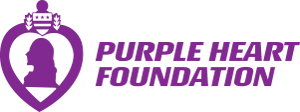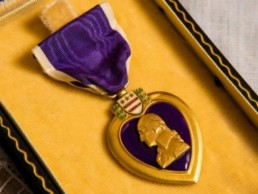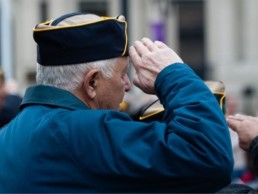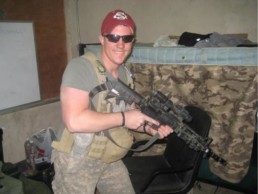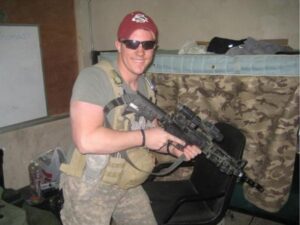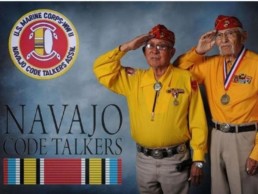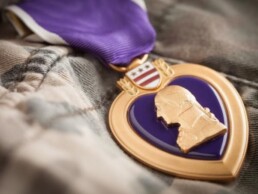John F. Kennedy: Purple Heart Recipient, Father, President
John Fitzgerald Kennedy (JFK), born May 29, 1917 in Boston, Massachusetts, was the only U.S. President in history (to-date) to receive the Purple Heart medal. Kennedy was born into a wealthy political family, travelled the world after high school, and followed in his father’s footsteps by becoming a ‘Harvard Man’. In spite of JFK’S graduating cum laude with a Bachelor of Arts in government and a concentration in International Affairs at Harvard, his older brother Joseph P. Kennedy, also a ‘Harvard Man’, was tapped by their father to seek the presidency. In 1941, before beginning a political journey, both Kennedy brothers enlisted in the United States military to demonstrate their pride and service to this country.
On one fateful night of August 1, 1943, Naval Lieutenant John F. Kennedy was commanded to torpedo Japanese destroyers carrying supplies to soldiers fighting allied forces. “It was as dark as if you were in a closet with the door shut,” recalled one of JFK’s crewmen, Barney Ross1. So with only 1 active engine, little visibility, in the dead of night, phosphorescent plankton exposing every movement in the water, no radar and Japanese fighter pilots flying overhead… the brave Lieutenant Kennedy and his 13-man crew attempted to carefully make their way through the waters of the Solomon Islands on Patrol Torpedo (PT) boats. Within moments, Japanese fighter pilots dropped 2 bombs nearby, giving away their position, and a 388ft Japanese destroyer rammed their helpless wooden PT-109’s. Many of his men were injured, an engineer named McMahon was badly burned and 2 died in the attack. After swimming hundreds of miles to collect his men on what remained of his PT-109 and spending the night in enemy waters with no sign of rescue, JFK began to assert his leadership and take command. He gathered his men for a democratic vote on what to do next, whether to fight or surrender if approached by the Japanese. It is said that the crew all responded, “It’s up to you, boss”. And so, he commanded his crew to swim to the nearest island. Suffering from his own back injury, Kennedy heroically took a piece of McMahon’s life jacket in his mouth and pulled his crewmember suffering from agonizing burns for 3 miles until they reached shore. The crew spent 24hrs on an island with no fresh water, inedible coconuts, and no other food sources before Kennedy suggested they swim to another nearby island. It was there, on August 5th, JFK ran into two native men whom he handed a smooth-shelled coconut that he had carved into it “NAURO ISL COMMANDER….NATIVE KNOWS POS’IT…HE CAN PILOT…11 ALIVE NEED SMALL BOAT…KENNEDY.” Somehow, that coconut shell made its way to a New Zealand infantry patrol who came to Kennedy’s aid and helped him get in contact with his base, saving his crew.
His bravery and injury sustained during that mission would earn him a Navy & Marine Corps Medal and the Purple Heart. That experience left an undeniable mark on the man who would become the nation’s 35th president. Throughout the rest of his service, John F. Kennedy held onto that soft-shelled coconut that saved his life and later turned it into a paperweight for his desk in the Oval Office.
Almost exactly one year later, his older brother Joe met his untimely demise during a volunteer mission where he was posthumously awarded the Purple Heart2. Joseph P. Kennedy’s death in 1944 would change John F. Kennedy’s course in history, as the task of seeking the presidency now fell to him, the eldest of his seven (7) remaining siblings.
JFK’s father used his political influence and boasted his son’s Purple Heart, war-hero reputation to support John’s rise to presidency but it was his humility, charisma and progressive ideology that helped him win. His campaign was a family affair, with his father’s funding, his family’s influence, and his brother as his campaign manager. His inauguration was just as family oriented, with his wife and two small children by his side the whole time. John F. Kennedy was sworn in as the 35th president on January 20, 1961, only 17 days after his son, John F. Kennedy Jr was born. “Busy as he was with his other responsibilities, he always took time to delight in his children…the nation shared in the warmth of their family affection 3”. JFK fought for equality, civil rights, health care reform and more, while maintaining a strong relationship with his family and their faith. The Kennedy era White House was described by First Lady Jaqueline Kennedy herself, as “Camelot”, the perfect fairytale land.
However, the fairytale ended on November 22, 1963 when President John F. Kennedy was assassinated during a motorcade ride from Dallas’ Love Field to give a speech at a local Trade Mart. Along the way, three shots were fired at the motorcade, two striking JFK, and only 30 minutes later at a nearby hospital the president was pronounced dead. Jaqueline Kennedy took an active role in planning her husband’s state funeral which took place at the Cathedral of St. Matthew the Apostle in Washington, DC. As John F. Kennedy’s flag draped casket was carried down the steps of the cathedral, three-year-old John F. Kennedy, Jr. rendered the final salute to his father.
Jacqueline Kennedy led the procession to his final resting place at nearby Arlington National Cemetery on foot and lit the eternal flame.
The last remaining member of John F. Kennedy’s immediate family is his daughter, Caroline, who remembers her father fondly. In a CNN interview she states “I’ve thought about him and missed him every day of my life, but growing up with out him was made easier thanks to all the people who kept him in their hearts, who told me that he inspired them to work and fight and believe in a better world.”4
We recognize the late president John F. Kennedy as not only a Purple Heart recipient, but as a husband, a son, a father and a good man that all others should aspire to emulate.
Happy Father’s Day.
Spreading Holiday Love
The spirit of giving brings us together, whether it’s giving Christmas presents under the tree or giving back in your community.
In an effort to spread holiday cheer, Purple Heart Foundation staff volunteered on Saturday, December 21, 2019 to serve a holiday meal and distribute care packages to homeless veterans at the Department of Veteran Affairs Community Resource & Referral Center, in Washington D.C., driven by the sole purpose, “to holistically enhance the quality of life of all veterans.”
It hurt to see the necessity in our own community; just think how many more homeless veterans are out there? As passionate employees of the Purple Heart Foundation that work hard to help as many veterans as possible, thoughts like this hit close to home. Our heroes deserve the very best after everything they’ve sacrificed.
Here’s what our volunteers said about their humble service on Saturday:
“It was a very positive experience. It felt really good to give back to those veterans who served” – Mitchell Theis
“The VA staff members had wonderful holiday spirit and I look forward to doing more volunteer work next year.” – Berhanu Adamu
The Purple Heart Foundation’s Marketing Manager, Amelia Kakar, said “It was very fulfilling to see all the veterans savoring the holiday meal we served, and to see their smiles as they opened our care packages. I’m also very proud of our staff who volunteered on a weekend to not only serve a holiday meal and distribute care packages but to bring hope, kindness and joy to homeless veterans who may not have been able to celebrate Christmas with family and friends this year. The experience was inspiring. My goal, as we move into a new decade, is to coordinate more experiences like this for our staff and corporate partners all over the country to work directly with their local veterans too.”
Purple Heart Foundation employee, Bianca Meruvia, has been volunteering since childhood with her mother, Luisa Meruvia, who also volunteered Saturday. Bianca said she chose a non-profit career path because “helping those in need fills my heart with joy. At one point in life I was in their position and I’m not ashamed because it made me the person I am today. I’m truly grateful for every little thing in life and everyone in it because when I needed help someone was there for me. I want them to know that I will be there for them and they’re not alone… especially at this time, which tends to be the hardest. It made me so happy to see the smiles on their faces.”
The staff enjoyed their experience giving back. Hands-on experiences such as this can be life changing for both the giver and receiver. Your support of the Purple Heart Foundation as we transition into 2020 will allow us to continue creating life changing experiences for our nation’s heroes. Donate by 11:59pm on New Years Eve USING THIS LINK, and our partners at Nexen Tire will double your donation!
Social Security Benefits & Veterans
How to Qualify for Social Security Disability Benefits the Same Time as VA Benefits
If you are a veteran who is disabled, you may qualify for both Veterans Administration (VA) benefits and Social Security Disability Insurance (SSDI) administered through the Social Security Administration (SSA). While both are disability programs administered by government agencies, both programs have very different criteria that must be met for an applicant to be approved for benefits. You can qualify for both VA benefits and SSDI if you meet the specific criteria established for both programs.
You can have pending applications with both agencies at the same time, or you might be approved for one program and awaiting approval for the other. VA benefits are provided for disabilities related to your military service only, and you don’t have to be totally disabled. Your VA benefits are based on the severity of your service-related disability and the compensation rating it receives.
Because there aren’t financial requirements that must be met to receive VA benefits, you can receive VA benefits along with another form of disability benefits at the same time. To receive SSDI, you must have worked enough to earn adequate credits – usually this is the equivalent of 5 years full-time out of the last 10 years. You must be completely disabled for at least a year, or have a condition expected to result in death. All your medical issues are considered together – regardless of whether they are related to your military service or not.
The Disability Approval Process
The VA will review your medical records associated with your military service. If you get approved for VA benefits first, it will not necessarily help your SSDI claim. At one time, getting a high compensability rating from the VA, such as 70 percent or more, would lead to additional consideration. The new regulations published by the SSA in 2017 indicate that the SSA will not take VA benefit approvals into consideration for an SSDI application, but the SSA will review any evidence the VA considered when making their decision. The SSA will use Department of Defense (DOD) or VA evidence to expedite SSDI claims for veterans who are Wounded Warriors or who have a 100% compensability rating through the VA.
The VA doesn’t give special deference to an approval for SSDI, the VA Is required by law to consider the records that the SSA had to review regarding your condition. The medical records reviewed by the SSA could prove beneficial by offering key evidence that might help the VA render a favorable decision for your claim. While you could have a lower compensability rating – such as 5% or 10% through the VA – you could be declared fully disabled by the SSA. The SSA will consider your service-related disability, such as a back problem or lung disease, and they will also consider medical problems not associated with your military service, such as arthritis, cancer, diabetes, and heart problems.
The Application Process
If you have applied for VA benefits, you should also apply for SSD. SSDI benefits are based on the claimant’s work history – so your eligibility also relies on the credits you have earned from working. In most instances, you must have worked 5 years full-time out of the last 10 years. If you wait too long, you will start losing credits and you will become ineligible for SSDI. The application process for Social Security disability benefits is fairly straightforward. You have the option of applying online on the SSA’s website or you can do so in person at a Social Security office. After you send in your application, you should hear back from the SSA regarding your claim within three to five months.
Resources Found Via:
- https://www.va.gov/
- https://www.ssa.gov/disability/
- https://www.ssa.gov/
- https://www.disabilitybenefitscenter.org/glossary/social-security-disability-work-credit
- https://www.disabilitybenefitscenter.org/blog/disability-benefits-warrior-transition-unit-program
- https://www.ssa.gov/applyfordisability/
- https://secure.ssa.gov/ICON/main.jsp
Daniel Prigge: Surviving the Hits
The Purple Heart Foundation connects with Purple Heart recipients to share their unforgettable stories of valor. Here on the Purple Heart Foundation blog, you will read about the personal experiences of some of our heroes. These veterans have proudly served and sacrificed to protect our nation. Daniel Prigge is one of them…he is lucky to be alive, and proud to share his story to inspire others to keep carrying on.
“My name is Daniel Prigge, I served a little over 10 years in the US Army. I was wounded on May 03, 2011. My vehicle was struck by three EFP roadside bombs. My convoy was hit with a total of five EFP’s and one EFP that did not go off. My truck was also hit by an RPG and small arms fire during the ambush.
I was on a small fourteen-man team that was PSD (Protective Service Detail) for the general in charge of the pull out of Iraq. On May 2nd, the general took a helicopter flight to a meeting right outside of Baghdad, Iraq. The next day, my team was on the way to pick him up and bring him back to our FOB (Forward Operating Base). We were on the outskirts of Baghdad on a route that had a fence line on the left side and a canal on the right side. We were using RG33L trucks – a mine-resistant light armored vehicle built longer than the RG-33 to hold twice as many people – due to how many people we would have to escort from place to place. We were traveling down the route when suddenly I see an RPG hit the front of my truck…seconds later I felt an explosion to the left side of my vehicle.
I was the truck commander of the convoy, I was knocked out from the explosion and had sustained injuries of a shifted spine, both knees completely blown out and dislocated, left hemiparesis, broken nose, intestinal problems, brain leakage as well as shrapnel hitting my eye and destroying my optic nerve.
After the explosion, our convoy was still under fire. I looked at the vehicle behind me and saw that the truck was burning on fire with my guys inside. Our coms were not working due to the explosion, I came-to, dismounted the truck and directed four guys including myself to bound in teams of two back to the burning vehicle. The burning vehicle was about three hundred meters behind us. The first and second truck in the convoy were not able to turn around and get us out of the kill zone due to the fence and the canal on the route. My team bounded three hundred meters and helped get the other guys on the team out of the burning vehicle. We were still under contact, but by this time we received help from the Iraqi Special Operations unit. We finally secured the kill zone about fifteen minutes into the fire fight.
I took off my helmet and that is when the back of my head swelled up. I wasn’t aware that the entire time, my helmet was acting as a make-shift compression bandage. So, once I took the helmet off, my head expanded, and I passed out on the ground next to an Iraqi Army truck. Due to the unexploded ordinance still hot in the kill zone it took the MEDEVAC helicopter three hours to land to take the wounded to the nearest FOB. I went through over fifty surgeries including back surgery, six knee surgeries to put cadavers and to put my tibia and fibula back together. My fibula is cut in half due to it completely dislocating.
I retired from the Army in 2015 and now own a Max Muscle Sports Nutrition store in Green Bay, Wisconsin. My awards include Iraqi Campaign Medal with two campaign stars, Army commendation Medal (4th award), Purple Heart (2nd award), Army Achievement Medal, Army Good Conduct Medal (3rd Award), National Defense Medal, Global War on Terrorism Medal, Army Service Ribbon, Combat Infantry Badge, Expert Infantry Badge, Ranger Tab, Parachutist Badge, CLS, Combatives level 3 and Tiger Swan qualified.“
Daniel Prigge, US Army, Retired, Purple Heart Recipient
To help the Purple Heart Foundation continually provide programs, services, scholarships and other opportunities to veterans like Daniel Prigge, make a donation today.
Help last “Navajo Code Talkers” This Memorial Day!
After the recent passing of 97 year old Navajo Code Talker, Fleming Begaye Sr., the Navajo Nation will be doing something special to honor the service and sacrifice of their veteran community.
This Memorial Day the Navajo Nation in Rock Point, Arizona will be hosting a Memorial Day Celebration to honor more than 74 veterans, multiple Purple Heart recipients, 2 Gold Star Moms and the last 2 remaining Navajo Code Talkers from World War II, Peter MacDonald and Thomas Begay!
This Navajo community is a small and humble group of Native Americans that live on reservation, so they have partnered with the Purple Heart Desert Thrift Shop in Mesa, Arizona to collect donations until May 24th. 100% of ALL cash donations in store or donations online will benefit the Navajo veterans and their Memorial Day Celebration!
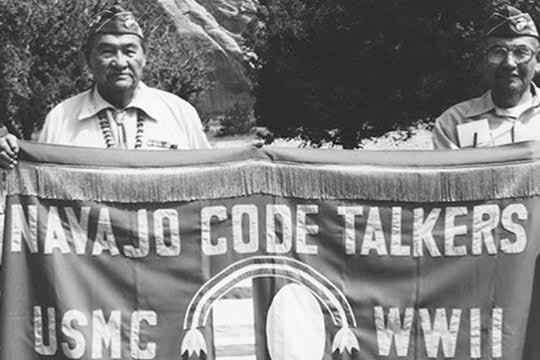
The Navajo Code Talkers have a unique history and are an infamous group of veterans that were recruited by the United States Marine Corps to use their native Navajo language to help maintain communication secrecy during the World War II. After the Navajo Code was developed, the Marine Corps established a Code Talking School where over 400 Navajos (Dine) were recruited as Code Talkers throughout World War II. The Japanese were never able to break these codes, that is why the Navajo Code Talkers are legendary – after WWII they were credited with helping the United States secure the Allied victory in the Pacific.
Navajo Nation President Jonathan Nez and Vice President Myron Lizer offered their heartfelt condolences to the family and loved ones of Navajo Code Talker Fleming Begaye, Sr., who passed away on Friday at the age of 97 in Chinle, Arizona.
“The Navajo Nation has lost another brave and selfless Diné warrior, who sacrificed more than we’ll ever know to defend our country,” said President Nez. “We offer our heartfelt appreciation to the family for sharing his life with us. May the Creator bless you and your family with strength and comfort.”
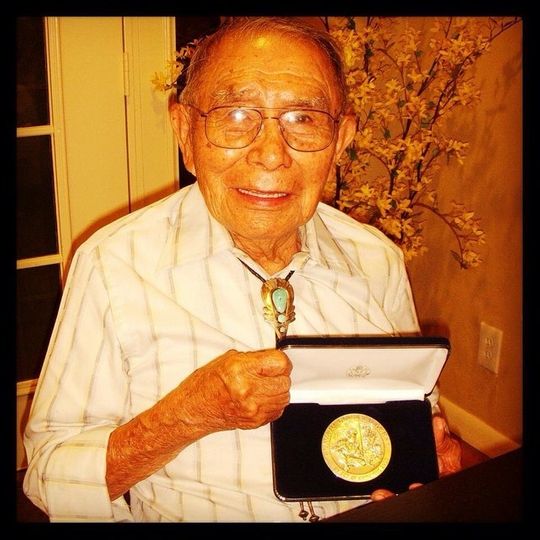
Navajo Code Talker Begaye is Tódích’íi’nii (Bitter Water Clan) and born for Kinłichii’nii (Red House People Clan). He was born on Aug. 26, 1921 in the community of Red Valley, Arizona and resided in Chinle, Arizona at the time of his passing. Begaye served as a Navajo Code Talker in the Marine Corps from 1943 to 1945 and fought in the Battle of Tarawa and the Battle of Tinian. He later spent one year in a naval hospital as a result of injuries and wounds he received during his service.
Following his military service, Begaye returned to the Navajo Nation where he owned and operated “Begaye’s Corner” trading post in the community of Chinle, where he also lived with his wife and three children.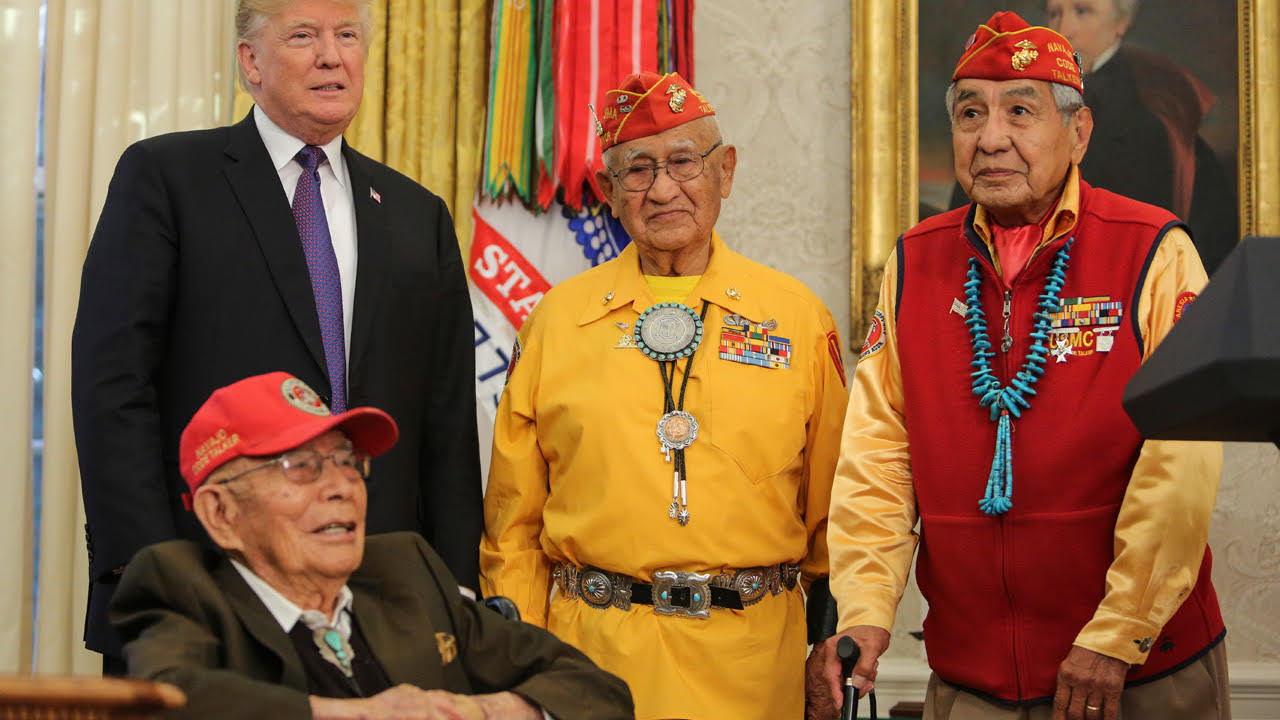
“Code Talker Begaye was a warrior, a family man, and a businessman. In every aspect of his life, he was a loving person who cared greatly for his people. Today, I ask our Diné people to keep his spirit and his family in your prayers as we give thanks for his life and his legacy,” said Vice President Lizer.
Funeral services and arrangements for Navajo Code Talker Fleming Begaye, Sr. are pending.
You can help the Navajo Nation honor Mr. Begaye’s heroic comrades, the last remaining Navajo Code Talkers, Peter MacDonald and Thomas Begay, as well as recognize dozens of other distinguished Navajo veterans and their families living on the Navajo reservation in Arizona….
Make a donation to the Navajo Nation Memorial Day Celebration at Purple Heart Desert Thrift!
100% of your donation will benefit the Navajo veterans and your donation is 100% tax-deductible! Help us honor their service and sacrifice!
Honoring Purple Heart Month
As we begin the month of August, it is our great pleasure to welcome you to
Purple Heart Month!
This month is dedicated to paying our respects to all the brave men and women wounded or killed in combat. The official Purple Heart Day is observed on the 7th day of August each year, commemorating the historic day in 1782 that General George Washington, Commander-In-Chief of the Continental Army, commissioned the first Purple Heart Medal, originally called the Badge of Military Merit.
The Badge of Military Merit is a purple, heart-shaped piece of silk bound with a thin edge of silver with the word merit embroidered in silver across the face. Only 3 Badges of Military Merit were awarded. The Badge of Military Merit was redesigned and re-commissioned in 1932 by General Douglas McArthur in honor of George Washington’s bicentennial birthday. Now known as the Purple Heart Medal – it is the oldest military award, first being awarded to soldiers in World War I and still given to soldiers today.
A presidential order signed in 1942 permitted the Purple Heart Medal to be awarded to all branches of the military including the U.S. Coast Guard. It was World War II, when the qualification to receive the Purple Heart Medal changed to honor those who were wounded or killed in combat – that is why it’s recipients often call it “the medal that nobody wants”. It is unknown how many soldiers actually received it. However, we know that the soldiers listed below are some of the most awarded Purple Heart Recipients in history:
Robert T. Frederick, U.S. Army: World War II (8)
David H. Hackworth, U.S. Army: Korean War (3), Vietnam War (5)
Joe Hooper, U.S. Army, Medal of Honor: Vietnam War (8)
Robert L. Howard, U.S. Army, Medal of Honor: Vietnam War (8)
William Waugh, U.S. Army: Vietnam War (8)
It took the Purple Heart medal many years to evolve into what it is today. Today, on the reverse of the medal, “FOR MILITARY MERIT” is inscribed. The medal itself is made of brass with a gold color to it, and also contains a bust of George Washington and his coat of arms. The purple color represents the blood of all those who have made sacrifices in war, but traditionally it represent the courage of those who serve. The original color of the medal George Washington created was purple, so it was only fitting that it would be used to honor his memory in the new medal.
The Military Order of the Purple Heart (MOPH) was formed in 1932. It is composed exclusively of men and women who have received the Purple Heart Medal and is the only Veteran’s Service Organization whose membership is comprised solely of “combat-wounded veterans”.
The Military Order of the Purple Heart Service Foundation, also known as the Purple Heart Foundation, was later created in 1957 as a non-profit organization. For more than 60 years, the Purple Heart Foundation has solely dedicated itself to funding programs and services that support our nation’s heroes. Donate to show your support of the Purple Heart Foundation and to help us continue to serve our nation’s veterans who have already sacrificed so much.
DONATE
